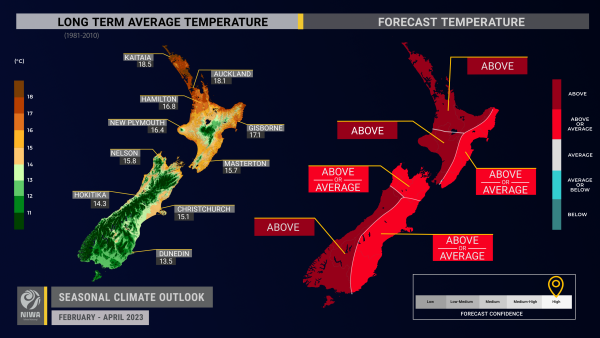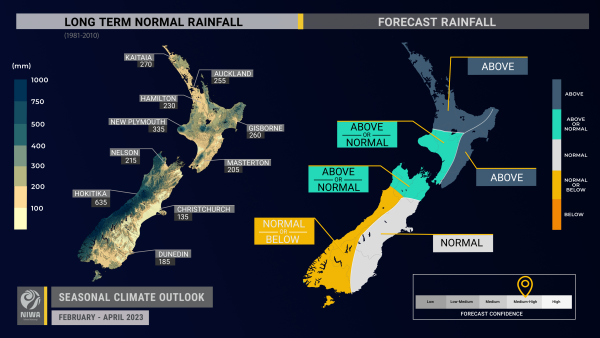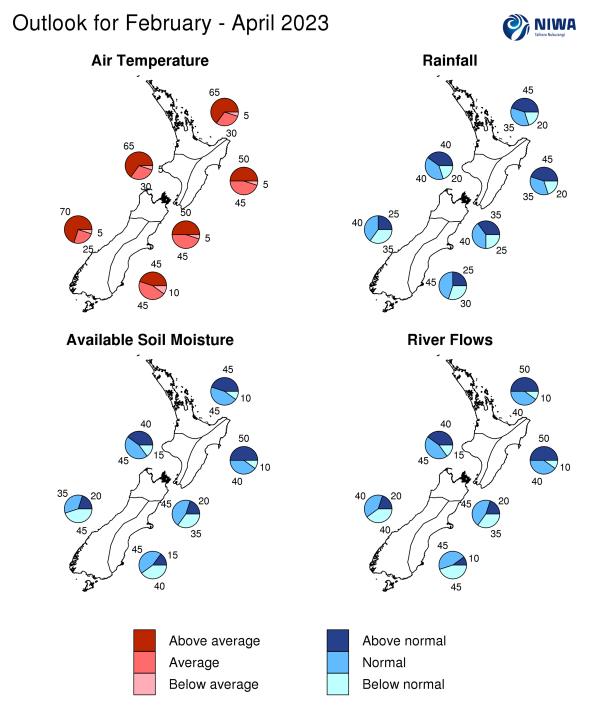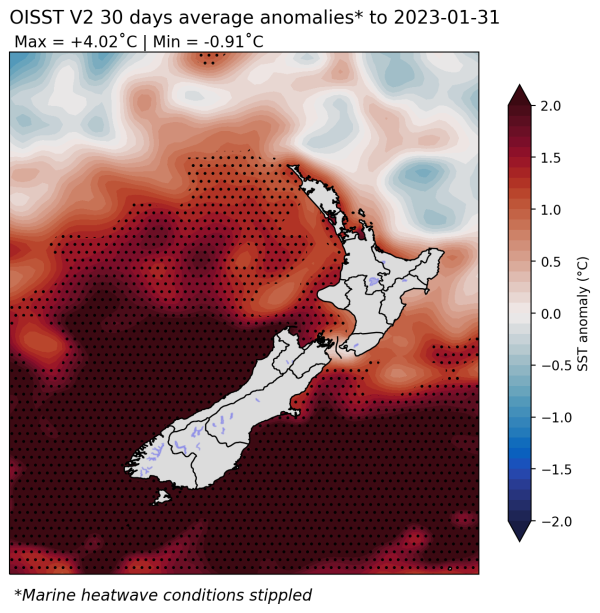Outlook summary
- La Niña continued during January, but it has gradually weakened. It will continue to affect Aotearoa New Zealand’s atmospheric patterns in coming months, even as neutral conditions are likely reached in early autumn. See more information.
- Coastal sea surface temperatures (SSTs) ranged from 0.7˚C to 3.2˚C above average during January and a Tasman Sea marine heatwave reached record levels along the coastal western South Island.
- Air pressure is forecast to be higher than normal over and to the south of the South Island and lower than normal north of the country. This is expected to be associated with an easterly quarter air flow anomaly for the season as a whole.
- Rainfall is most likely to be above normal in the north and east of the North Island, near normal in the east of the South Island, equally likely to be near normal or above normal in the west of the North Island and north of the South Island, and equally likely to be near normal or below normal in the west of the South Island.
- The rainfall outlook indicates that heavy rainfall and possible flooding are possible. Therefore, continued preparedness for extreme weather impacts in the weeks and months ahead for the North Island and northern South Island is warranted. Dry conditions in the lower South Island may persist.
- There is an equal likelihood of temperatures being near average or above average in the north and east of the South Island and east of the North Island. Temperatures are very likely to be above average across the remainder of the country.
- During the first week of February, hot temperatures in the 30-35˚C range are forecast for the inland and eastern South Island. However, for the three months as a whole, a reduction in northwesterly winds will likely mean fewer warm days than normal for eastern areas. Sub-tropical air masses, in conjunction with marine heatwave conditions, may elevate overnight temperatures and humidity while also delaying the typical transition to cooler temperatures for much of the country.
- The risk for tropical cyclones in the Southwest Pacific may increase during mid-to-late February. The effects from these storms as they decay and approach the country can cause flooding rainfall, strong winds, and coastal hazards.
- At the start of February, soil moisture levels were well above normal across much of the North Island and well below normal in parts of the West Coast, Otago, and Southland.
- Soil moisture levels are most likely to be above normal in the east of the North Island, near normal in the north of the South Island, below normal in the west of the South Island, about equally likely to be near normal or above normal in the north and west of the North Island, and about equally likely to be near normal or below normal in the east of the South Island.
- River flows are most likely to be above normal in the north and east of the North Island, near normal in the north of the South Island, about equally likely to be near normal or above normal in the west of the North Island, and equally likely to be near normal or below normal in the east and west of the South Island.
Regional predictions for February – April 2023
Northland, Auckland, Waikato, Bay of Plenty
The table below shows the probabilities (or percent chances) for each of three categories: above average, near average, and below average. In the absence of any forecast guidance there would be an equal likelihood (33% chance) of the outcome being in any one of the three categories. Forecast information from local and global guidance models is used to indicate the deviation from equal chance expected for the coming three-month period, with the following outcomes the most likely (but not certain) for this region:
- Temperatures are very likely to be above average (65% chance). More winds of tropical-origin and above average coastal SSTs will likely result in above average overnight temperatures and higher humidity, but increased cloudiness may lead to cooler daytime temperatures.
- Rainfall totals are most likely to be above normal (45% chance). Sub-tropical low pressure systems and/or atmospheric rivers are forecast to occasionally impact the region, increasing the risk for heavy rainfall and flooding.
- Soil moisture levels are equally likely to be near normal or above normal (45% chance each) while river flows are most likely to be above normal (50% chance).
The full probability breakdown is:
|
Temperature |
Rainfall |
Soil moisture |
River flows |
|
|
Above average |
65 |
45 |
45 |
50 |
|
Near average |
30 |
35 |
45 |
40 |
|
Below average |
05 |
20 |
10 |
10 |
Central North Island, Taranaki, Whanganui, Manawatu, Wellington
Probabilities are assigned in three categories: above average, near average, and below average.
- Temperatures are very likely to be above average (65% chance). Marine heatwave conditions will likely contribute to above average warmth and humidity.
- Rainfall totals are equally likely to be near normal (40% chance) or above normal (40% chance). Occasional tropical moisture plumes will increase the risk for heavy rainfall and reduce the chances for a drier than normal three-month period.
- Soil moisture levels and river flows are about equally likely to be near normal (45% chance) or above normal (40% chance).
The full probability breakdown is:
|
Temperature |
Rainfall |
Soil moisture |
River flows | |
|
Above average |
65 |
40 |
40 |
40 |
|
Near average |
30 |
40 |
45 |
45 |
|
Below average |
05 |
20 |
15 |
15 |
Gisborne, Hawke’s Bay, Wairarapa
Probabilities are assigned in three categories: above average, near average, and below average.
- Temperatures are about equally likely to be near average (45% chance) or above average (50% chance). More frequent onshore winds and above average coastal SSTs may lead to higher humidity levels, more cloud cover, and warmer overnight temperatures. Fewer northwesterly winds will likely continue to limit the number of days above 25˚C.
- Rainfall totals are most likely to be above normal (45% chance). Sub-tropical low pressure systems and/or atmospheric rivers are forecast to occasionally impact the region, increasing the risk for heavy rainfall and flooding.
- Soil moisture levels and river flows are most likely to be above normal (50% chance).
The full probability breakdown is:
|
Temperature |
Rainfall |
Soil moisture |
River flows | |
|
Above average |
50 |
45 |
50 |
50 |
|
Near average |
45 |
35 |
40 |
40 |
|
Below average |
05 |
20 |
10 |
10 |
Tasman, Nelson, Marlborough, Buller
Probabilities are assigned in three categories: above average, near average, and below average.
- Temperatures are about equally likely to be near average (45% chance) or above average (50% chance). Marine heatwave conditions may lead to higher humidity levels and warmer overnight temperatures in particular; however, more easterly, onshore winds could lead to increased cloud and cooler daytime temperatures, especially in Marlborough.
- Rainfall totals are about equally likely to be near normal (40% chance) or above normal (35% chance). Occasional tropical moisture plumes will increase the risk for heavy rainfall and reduce the chances for a drier than normal three-month period.
- Soil moisture levels and river flows are most likely to be near normal (45% chance).
The full probability breakdown is:
|
Temperature |
Rainfall |
Soil moisture |
River flows | |
|
Above average |
50 |
35 |
20 |
20 |
|
Near average |
45 |
40 |
45 |
45 |
|
Below average |
05 |
25 |
35 |
35 |
West Coast, Alps and foothills, inland Otago, Southland
Probabilities are assigned in three categories: above average, near average, and below average.
- Temperatures are very likely to be above average (70% chance). More easterly-quarter winds and marine heatwave conditions will result in high heat and humidity at times.
- Rainfall totals are about equally likely to be near normal (40% chance) or below normal (35% chance). The odds for a drier than normal three-month period are reduced when compared to last month, aligned with a gradual easing of La Niña. Heavy rainfall is expected during the first week of February and may occur again in the middle part of the month.
- Soil moisture levels are most likely to be below normal (45% chance) and river flows are equally likely to be near normal or below normal (40% chance each).
The full probability breakdown is:
|
Temperature |
Rainfall |
Soil moisture |
River flows | |
|
Above average |
70 |
25 |
20 |
20 |
|
Near average |
25 |
40 |
35 |
40 |
|
Below average |
05 |
35 |
45 |
40 |
Coastal Canterbury, east Otago
Probabilities are assigned in three categories: above average, near average, and below average.
- Temperatures are equally likely to be near average or above average (45% chance each). Maximum temperatures above 30˚C are expected during the first week of February, but for the three months as a whole, more frequent onshore winds and marine heatwave conditions may contribute to more cloud cover, higher humidity, and warmer overnight temperatures but also lead to cooler daytime temperatures.
- Rainfall totals are most likely to be near normal (45% chance). Anticyclones, or high pressure, over parts of the country may continue to increase the risk for dry spells, particularly in the southern half of the region. However, more frequent onshore winds may lead to more wet days (more than 1 mm of rainfall) than normal. Impacts from occasional tropical moisture plumes on the region are also possible, particularly for North Canterbury.
- Soil moisture levels and river flows are about equally likely to be near normal (45% chance) or below normal (40-45% chance).
The full probability breakdown is:
|
Temperature |
Rainfall |
Soil moisture |
River flows | |
|
Above average |
45 |
25 |
15 |
10 |
|
Near average |
45 |
45 |
45 |
45 |
|
Below average |
10 |
30 |
40 |
45 |
Graphical representation of the regional probabilities
Background
The NINO3.4 Index anomaly (which covers the west-central equatorial Pacific) over the last month (through 31 January) was -0.69˚C (climatology: 1991-2020), close to La Niña threshold levels. La Niña’s intensity continued to wane during January, with the strongest cool water anomalies relative to average contracting into the central Pacific.
The January monthly Southern Oscillation Index (SOI) was +1.0 and +1.0 from November-January (climatology: 1991-2020), both La Niña threshold values.
January trade winds were stronger than normal in the central and western equatorial Pacific and near normal or weaker than normal in the east. This enabled the continuation of central Pacific-focused La Niña while SSTs increased in the east. Periods of weaker trade winds are expected in February, particularly in the east-central part of the Pacific basin. However, trade wind strength is forecast to persist in the west-central Pacific, preventing a rapid decay of the current La Niña event.
In the subsurface equatorial Pacific, warmer than average water, associated with La Niña’s weakening, has developed in the far eastern equatorial Pacific around 50 m depth. A remnant cool water anomaly is located near the surface in the central Pacific, which will likely allow a La Niña-like ocean signature to persist for another month or two. Any substantial relaxation or reversal in trade winds over the next three months will move the system toward ENSO-neutral.
NIWA’s analysis indicates that La Niña will most likely transition to ENSO-neutral during February-April (80% chance), most likely by the end of March. During May-July, ENSO neutral is favoured at around a 50% chance. The chance for El Niño conditions increases to around 55% from August-October 2023. The last time El Niño conditions were observed during winter and spring was 2015. It should be noted that ENSO forecasts made just before and during Northern Hemisphere spring have lower skill (known as the spring predictability barrier).
During November-January, tropical forcing was influenced by the low frequency signal of the negative Indian Ocean Dipole that eased in late 2022 and La Niña conditions with periodic Madden-Julian Oscillation (MJO) activity. This combination of factors was associated with anomalous rising air from the eastern tropical Indian Ocean into the Coral Sea with sinking air over the central and eastern Pacific. Tropical forcing was also noted over South America, the Atlantic Ocean, and Africa, which will likely continue to be a source of large-scale climatic variability, particularly as La Niña weakens.
During late January, a strong MJO pulse developed over the Indian Ocean (phase 3). The MJO is forecast to move from phase 3 into the Maritime Continent (phases 4-5) during the first half of February. A weakened MJO wave may pass over the Pacific during the 3rd week of the month. Another MJO event may develop over the Indian Ocean in late February, before moving into the Maritime Continent and potentially the Pacific during March.
During February, phase 3 of the MJO is typically associated with wetter than normal conditions in the western South Island, consistent with the early month forecast. Phase 4 of the MJO, which may be reached by mid-month, is associated with wetter conditions in the northern North Island while phase 5 tends to bring wetter conditions to most of the country. Above average temperatures are common in the South Island during phase 3 of the MJO, which is consistent with the forecast during the first week of February.
Phases 4 and 5 of the MJO, which may be prominent during March, favour above normal rainfall in the northern North Island (phase 4) and in much of the country aside from the lower South Island (phase 5).
Overall, this short-term prognosis suggests that continued preparedness for heavy rainfall and possible flooding is needed in the weeks and months to come, while dry conditions in the lower South Island may persist.
The Southern Annular Mode (SAM) was positive every day during January. Positive SAM conditions are likely to persist over the next three months, although some negative SAM spells are possible, particularly as the effect of La Niña gradually wanes.
New Zealand’s coastal water temperatures became less unusually warm during January in all regions except the west and east of the South Island. The January monthly anomaly value of +3.15˚C in the west of the South Island surpassed the previous monthly record of +2.58˚C set during the exceptional marine heatwave of January 2018. The January monthly anomaly of +1.89˚C (+1.55˚C) in the east (north) of the South Island was the 2nd highest on record to January 2018. At the end of January, marine heatwave conditions were widespread around the South Island and in parts of the western and lower North Island. Stronger winds and more low pressure activity during February should see SSTs become less unusually warm. The NIWA Sea Surface Temperature Update suggests that MHW conditions may last into autumn and may delay the seasonal transition to cooler temperatures.
NZ 30-day coastal SST anomalies (to 31 January)
|
North NI |
+0.97˚C |
|
West NI |
+0.97˚C |
|
East NI |
+0.69˚C |
|
North SI |
+1.55˚C |
|
West SI |
+3.15˚C |
|
East SI |
+1.89˚C |
Forecast Confidence
Temperature
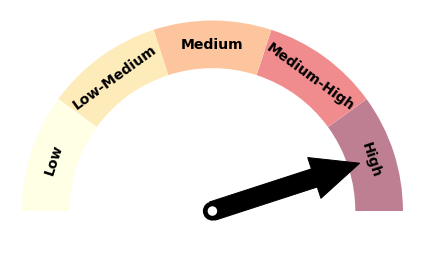
|
Forecast confidence for temperatures is high. The combination of a continued La Niña influence and marine heatwave conditions will elevate the chance for above average temperatures and delay the seasonal transition to cooler temperatures, particularly about inland and western parts of both islands. However, more easterly air flows and cloud will likely continue to reduce the number of warm days in the east. |
Rainfall
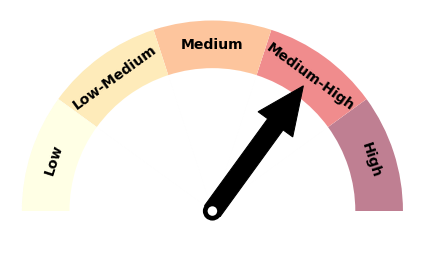
|
Forecast confidence for rainfall is medium-to-high. There is above average model agreement on rainfall outcomes, owing to a continued influence from La Niña. A likelihood of more moist, sub-tropical winds will increase the odds of wetter than normal conditions in the North Island and northern South Island. The most model spread (disagreement) is in the eastern South Island, where rainfall may continue to be irregular due to high pressure systems located near the region. |

